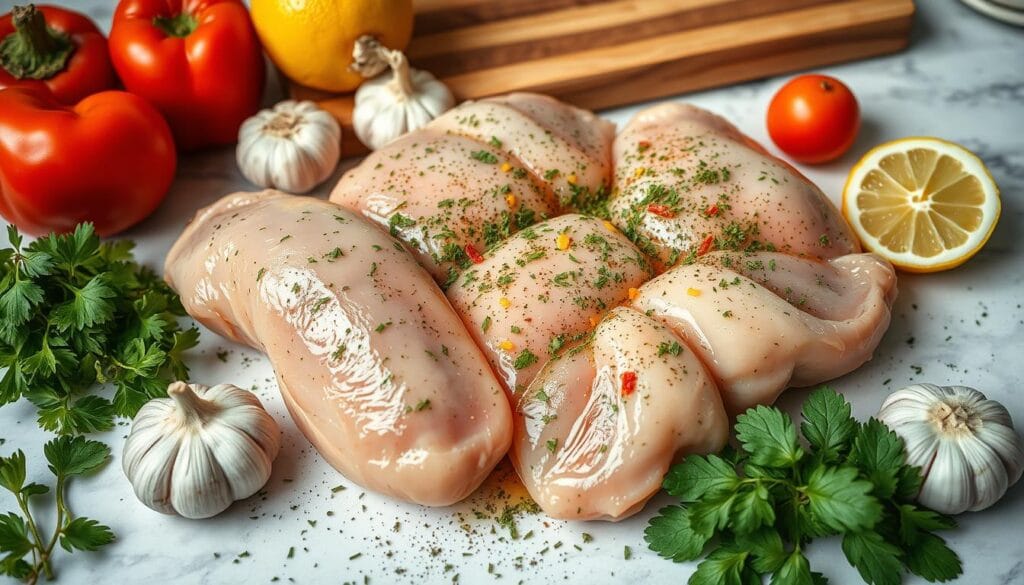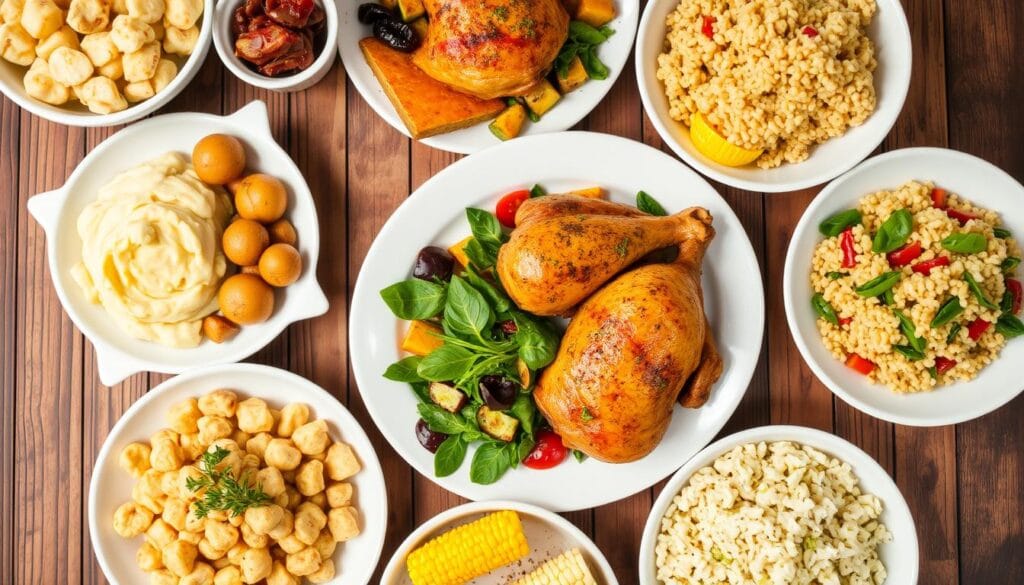Imagine the smell of golden-brown roasted chicken filling your home. It’s a sign of a cozy meal for everyone. As you get ready to make this dish, you wonder: Do you flip chicken when roasting?
Table of Contents
This isn’t just about what you like. The answer can change how juicy and tasty your chicken turns out. Learning about roasting chicken helps you make key choices in cooking. These choices affect everything from crispy skin to even cooking.
In this guide, we’ll share important tips for cooking poultry. These tips are for both experienced cooks and beginners in the kitchen.
Understanding the Roasting Process
Roasting chicken is a magical process that turns raw meat into a tasty dish. It uses dry heat to cook evenly and brings out flavors through chemical reactions. Knowing about these changes can help you make a better oven-roasted chicken.
What Happens to Chicken When Roasted?
Roasting chicken changes it in many ways. Heat makes the meat release moisture, and the outside gets a crispy, browned skin. This not only adds flavor but also makes the chicken feel good to eat.
With the right cooking methods, you can get a chicken that’s tender inside and crispy outside. This makes your chicken dish truly special.
Key Factors That Affect Cooking Time
Several things affect how long it takes to cook chicken. Knowing these can help you roast chicken perfectly:
- Weight of the Chicken: Bigger chickens need more time to cook.
- Oven Temperature: Cooking at higher temperatures can be faster but might dry out the meat.
- Stuffing: Stuffed chickens take longer to cook safely.
By keeping these factors in mind, you can always make perfectly roasted chicken.
Benefits of Flipping Chicken
Flipping chicken while it roasts brings many advantages. It ensures the chicken cooks evenly and boosts flavor. Learning about these benefits can make your chicken roasting better.
Ensuring Even Cooking
Flipping chicken is key for even cooking. It lets heat reach both sides, so the chicken roasts evenly. This method helps avoid undercooked spots, making your chicken safer and tastier.
Enhancing Flavor Development
Flipping also makes the chicken taste better. As it roasts, the skin gets crispy and browns, creating deep flavors. This method is great for getting a chicken with rich, complex tastes.
| Benefit | Description | Impact on Roasting |
|---|---|---|
| Even Cooking | Allows heat to penetrate evenly, avoiding undercooking. | Improved texture and safety. |
| Flavor Development | Enhances the Maillard reaction for richer flavor. | Deeper flavors with crispy skin. |
The Case for Not Flipping
Roasting chicken can make you think about flipping it. But, leaving it alone has big benefits. It keeps the chicken moist and looks great.
Juiciness Preservation
Not flipping helps keep the chicken juicy. As it cooks, the juices stay inside. This makes the chicken tender and flavorful.
Skin Crispiness
Not flipping also makes the skin crispy. The fat renders evenly, making the skin golden and crunchy. This adds a nice texture and look to your dish.
| Technique | Juiciness Preservation | Skin Crispiness |
|---|---|---|
| Flipping Chicken | Moderate | Less Crisp |
| Not Flipping Chicken | High | High |
Best Practices for Roasting Chicken
To make the perfect oven-roasted chicken, follow some key best practices. These tips will help you improve the taste and texture. Understanding cooking techniques and preparation is key.
Choosing the Right Cooking Temperature
Choosing the right cooking temperature is very important. Most recipes suggest a temperature between 375°F and 450°F. The temperature you choose affects the chicken’s skin and meat.
Here’s a quick guide to help you:
| Cooking Temperature (°F) | Effect | Recommended Cooking Time |
|---|---|---|
| 375 | Moist and evenly cooked chicken | 1 hour 15 minutes |
| 400 | Golden brown skin with juicy meat | 1 hour |
| 425 | Crispy exterior, less tenderness | 50 minutes |
| 450 | Very crispy skin, risk of drying out | 40 minutes |
Tools You’ll Need for Roasting
Having the right tools makes roasting chicken easier. A good roasting pan helps with even cooking. A meat thermometer ensures the chicken is cooked just right.
A convection oven can also make your chicken roast better. It circulates hot air for a more even roast.
Recommended Roasting Techniques
Mastering certain techniques is key to roasting chicken well. The right tips can make your cooking better and more enjoyable. Two top techniques are great for flavor and quick cooking.
Spatchcocking for Faster Cooking
Spatchcocking means removing the chicken’s backbone and flattening it. This method cooks the chicken faster because more of it is exposed. It also cooks more evenly.
By spatchcocking, you get a juicier and tastier chicken. It’s a great way to improve your cooking.
Using a Roasting Rack for Even Heat Distribution
Using a roasting rack is another smart move. It lets hot air circulate around the chicken evenly. This leads to a chicken that’s perfectly cooked.
The chicken gets crispy skin and a tender inside. A roasting rack keeps the chicken dry, avoiding sogginess. These techniques can really boost your cooking skills.
Flavoring Your Chicken Before Roasting
Flavoring chicken is key to a tasty meal. You can use marinades or dry rubs. Each method has its own benefits. Knowing how to use them will make your roasted chicken even better.
Marinades vs. Dry Rubs
Marinades add moisture and flavor to your chicken. They need at least 30 minutes to overnight to work well. They use oils, acids, and seasonings for a tender chicken.
Dry rubs give a strong flavor that sticks to the chicken’s skin. Apply them just before roasting for a savory crust. They use spices, salts, and herbs to enhance the chicken’s taste.
Timing of Seasoning
When you season your chicken matters a lot. Marinades need time to soak in flavors. Dry rubs should go on just before roasting for the best taste.

Choosing between marinades and dry rubs changes your chicken’s flavor. It’s all about how you flavor your chicken before roasting.
| Flavoring Method | Preparation Time | Flavor Impact | Texture |
|---|---|---|---|
| Marinades | 30 minutes to overnight | Deep, infused flavors | Tender and moist |
| Dry Rubs | Directly before roasting | Concentrated flavor on the surface | Crispy skin |
Monitoring Chicken Doneness
It’s key to make sure your chicken is cooked right for taste and safety. There are a few ways to check if it’s done. The best method is using a meat thermometer to see the chicken’s internal temperature.
Importance of a Meat Thermometer
A meat thermometer gives you precise readings. This means you won’t worry about undercooking or overcooking. For chicken, aim for an internal temperature of 165°F. This method keeps the meat safe and the juices inside, making it taste great.
Color and Texture Indicators
Visual signs also help tell if chicken is cooked. Look for:
- Clear juices: Juices should run clear, not pink.
- Golden brown color: The skin should have a nice golden hue, indicating proper roasting.
- Firm texture: The meat should feel firm to the touch, assuring it’s fully cooked.
Common Mistakes to Avoid When Roasting
Knowing common mistakes can make you better at roasting. To master roasting chicken, it’s key to avoid these errors. This way, you get the best taste and texture. Here are two big mistakes and how to fix them.
Overcrowding the Pan
Putting too much chicken in a pan makes it steam instead of roast. This causes uneven cooking and bad texture. To avoid this, make sure each piece has enough room. Use separate pans or a bigger one if needed.
Opening the Oven Too Often
Opening the oven too much messes up the cooking. It makes the temperature uneven and can make cooking take longer. To fix this, use a meat thermometer to check the chicken. This is a top roasting chicken tip for better results.
| Mistake | Effect | Solution |
|---|---|---|
| Overcrowding the Pan | Steaming instead of roasting | Use ample spacing or larger pans |
| Opening the Oven Too Often | Inconsistent cooking temperature | Check with a meat thermometer |
Side Dishes That Pair Well with Roasted Chicken
Creating a memorable meal around your roasted chicken is easy with the right side dishes. Choose classic vegetables that complement the chicken’s rich flavors. Also, pick creative starches to enhance your dining experience with complete meal ideas.
Classic Vegetables to Roast Alongside
Roasting classic vegetables adds color to your plate and boosts the flavor of your meal. Root vegetables like carrots, potatoes, and parsnips soak up the chicken’s juices. Seasonal greens such as Brussels sprouts or asparagus offer a fresh contrast to the savory chicken.
- Carrots
- Potatoes
- Parsnips
- Brussels Sprouts
- Asparagus
Creative Starches for a Complete Meal
To round out your meal, consider creative starches that add substance and flavor. Dishes like risotto or couscous provide a comforting element. Crusty bread is perfect for soaking up the delicious drippings from the roasted chicken. These options help transform your roasted chicken into a satisfying feast.
| Starch Options | Flavor Profile | Preparation Time |
|---|---|---|
| Risotto | Creamy and rich | 20-30 minutes |
| Couscous | Light and fluffy | 5-10 minutes |
| Roasted Potatoes | Crispy and savory | 30-40 minutes |
| Crusty Bread | Chewy and satisfying | 10-15 minutes (for warming) |

Conclusion: Flipping or Not Flipping?
Thinking about roasting chicken, you might wonder if to flip or not. Flipping can make the chicken cook evenly and taste better. Or, you might prefer not to flip for juicier meat and crisper skin.
Knowing these points helps you pick the best method for you. It lets you make your cooking just how you like it.
Personal Preference vs. Culinary Technique
Whether to flip chicken depends on your cooking style. Some people flip to ensure even heat. Others prefer not to flip, showing off their skill in roasting.
It’s really about what you like and what you aim for in your cooking.
Final Thoughts on Achieving Perfect Roast Chicken
Choosing to flip or not, remember that perfect roast chicken is worth the effort. Knowing about timing, seasoning, temperature, and doneness helps you improve your dish.
Embrace the cooking process, try new things, and enjoy the tasty results of your efforts.
FAQ
Do you flip chicken when roasting?
Flipping chicken while roasting can help cook it evenly and add flavor. But, some say not flipping keeps the chicken moist and the skin crispy.
What temperature should I roast chicken at?
Roast chicken at 375°F to 450°F. Higher temperatures make the skin crispy, while lower temperatures keep the meat juicy.
How do I know when my roasted chicken is done?
Use a meat thermometer to check if the chicken is done. It should read 165°F. Also, the juices should be clear, and the skin golden brown.
Should I use a roasting rack?
Yes, a roasting rack helps air circulate. This prevents sogginess and makes the skin crispy.
What are some common mistakes to avoid when roasting chicken?
Avoid overcrowding the pan and opening the oven too often. These actions can ruin the chicken’s even cooking.
How can I enhance the flavor of my roasted chicken?
Use marinades or dry rubs to flavor your chicken. Marinades need time, while dry rubs work right before roasting.
What side dishes pair well with roasted chicken?
Roasted chicken goes well with roasted veggies like carrots and potatoes. Grains like risotto or couscous also make a great pair.

